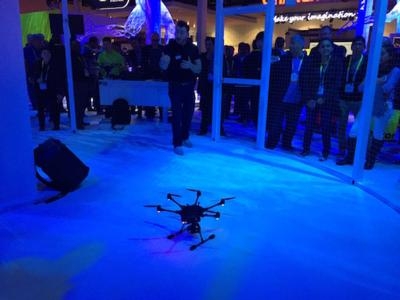Tue, Jan 12, 2016
Novelty Of The Aircraft Wearing Off ... Serious Work Begins
As drones of all sizes and shapes proliferated at CES, companies are starting to highlight their ability to safely integrate unmanned systems into the airspace by incorporating new features, such as robust sense-and-avoid capability.

Some of the chief proponents of this are companies that haven't traditionally operated in the air arena, including computer giant Intel and telecommunications company Qualcomm.
Intel has stepped into the drone market in a big way, investing $60 million in Chinese company Yuneec, which builds a range of small unmanned aircraft, and acquiring German autopilot maker Ascending Technologies.
At CES, Intel demonstrated its RealSense collision avoidance technology. In a keynote address, Intel CEO Brian Krzanich showed how a Yuneec drone equipped with the technology could follow a bicyclist’s movements and even avoid a falling tree.
At its booth, Intel flew another Yuneec drone with RealSense, which flew around a netted area without crashing, even when the operator flew it with his eyes closed.
Intel presenter Trent Nate said RealSense uses infrared cameras to give it depth perception to “entirely” avoid collisions. "He can't crash this drone," he said, of the operator. "It will even pick up this netting as an obstacle."
Qualcomm has created a similar sense-and-avoid system using the company’s Snapdragon processing that won't allow a UAS to hit obstacles and which will guide it back to a safe home point if it loses connection to its operator. "Want to see us crash this drone?" a company spokesman asked during a demonstration at the company's booth at CES 2016.
The operator tried to crash the drone into a wall, but it wouldn't let him. He tried to run it into a mock rock arch, but it just went through.
The system is almost entirely optically based, said Qualcomm senior engineer Abhishek Tyagi, although it also uses data from built-in accelerometers. The prototype can be bolted onto a small UAS, but Tyagi said it could be added in at the design level as well if drone manufacturers wanted to use it.
Sense-and-avoid capability isn't the only factor holding up integration. Several panelists at a session on Wednesday said regulation is needed, along with some possible technology advances. NASA is working on an unmanned traffic management system for small UAS, along with partners, including Intel, Amazon, Google, Ascending Technologies and many others.
Intel's Peter Cleveland, vice president of the law and policy group, said latency is a potential problem. Consumer drones can take a couple of seconds or more to regain a lost link, but that won't be acceptable in commercial use. However, Google's Dave Vos, who heads Google[x]'s Project Wing drone delivery system, said there really aren't any technical issues standing in the way of commercial use. "We just need to do it."
He said latency issues could be mitigated by making communications a "non-critical link," so drones would be more autonomous. They will also need to communicate their location at all times, which will help in avoiding collisions.
(Source: AUVSI blog. Image provided by AUVSI)
More News
Hazardous Weather Information Summary of significant meteorological information (SIGMET/WS), convective significant meteorological information (convective SIGMET/WST), urgent pilot>[...]
Aero Linx: The T-6 Racing Association The T-6 Racing Association is all about T-6‘s and racing. Our mission is to bring great racing to our fans in Reno and other venues wher>[...]
Also: Electra Aero, AMO-CBP v Smugglers, Naval King Airs, Boeing Deal To the surprise of everyone involved, Waco Kitchen shut down both airport operations with little warning and h>[...]
Also: WACO Kitchen Bails, French SportPlane Mfr to FL, Dynon-Advance Flight Systems, Innovation Preview Bobby Bailey, a bit of a fixture in sport aviation circles for his work with>[...]
Also: Virgin Galactic, B-29 Doc to Allentown, Erickson Fire-Fighters Bought, FAA Reauthorization After dealing with a big letdown after the unexpected decision by Skyreach to disco>[...]
 ANN's Daily Aero-Term (05.07.24): Hazardous Weather Information
ANN's Daily Aero-Term (05.07.24): Hazardous Weather Information ANN's Daily Aero-Linx (05.07.24)
ANN's Daily Aero-Linx (05.07.24) Airborne 05.01.24: WACO Kitchen, FAA Reauthorization, World Skydiving Day
Airborne 05.01.24: WACO Kitchen, FAA Reauthorization, World Skydiving Day Airborne Affordable Flyers 05.02.24: Bobby Bailey, SPRG Report Cards, Skydive!
Airborne Affordable Flyers 05.02.24: Bobby Bailey, SPRG Report Cards, Skydive! Airborne 05.03.24: Advanced Powerplant Solutions, PRA Runway Woes, Drone Racing
Airborne 05.03.24: Advanced Powerplant Solutions, PRA Runway Woes, Drone Racing



